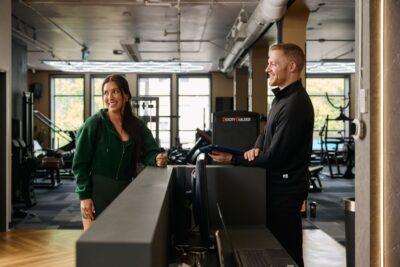We asked Dominic Munnelly, PT and co owner of The Performance and Fitness Academy, to share top tips to help trainers make a successful transition to a business owner mindset!
After completing a Sports Science degree in the UK, Dominic returned to the stark reality that was Ireland’s fledgling fitness industry. Working for a while in a large commercial style gym, Dominic decided to take advantage of the gap in the market and began personal training in his local park.
From here, demand grew and he moved on to establish his own facility which morphed into a very successful personal training business. Dominic then set up a gym with his brother, called The Performance and Fitness Academy. Starting out as a 1000 square foot facility, they’ve grown to 8,500 square foot, 4 full time staff and close to 200 members.
Check out Dominic’s advice for making the switch to an owner below!

1. Let’s Talk Payment
One thing to remember when making the switch from trainer to business owner is that you have to get paid, end of story. When you’re a trainer in a large facility, you may be used to or have the luxury of leaving the payment conversations to reception staff.
When you’re running your own business, there’s no two ways about it. if you don’t do it, nobody will! You don’t go to a doctor and get a consultation without them asking you to pay at the end of your visit, do you? Why should a session with a Personal Trainer be any different? Before you start the session with a new or current client, why not politely ask: “How would you like to pay or do you need change for the payment?” This breaks the ice and gets the payment question out of the way and also sets the basis upon which future payments will be made. Of course, if you choose to implement a gym management software, your client will have paid prior to their session, eliminating that awkward payment conversation for good!
2.Think Value Based Pricing
Being a business owner involves thinking about prices in a strategic way. By making the mistake of pricing your service based on what a competitor up the road charges or what you think you should charge, you risk undervaluing your service and subsequently losing out on revenue.
Value based pricing on the other hand, is all about identifying the highest price that customers are willing to pay based on their perceived value of the service on offer. How can you find your value based price? This leads us into our next point…
The Customer
Engagement Playbook
for Your Fitness
Business
Discover more 3.Finding Your Value Based Price
The best way to find your value based price is to take the plunge and get talking to potential customers. Firstly, you need to think tactically about location. Where are you going to find contacts with the disposable income required to pay for a personal training service? Is it a local hair salon or a shopping center? You’ll have the chance to test reactions to the various prices you are considering for your service.
For example, if potential customer one doesn’t bat an eyelid to €40 per training session, you could test a higher price with the next potential customer you speak with and again and again until you get a reaction that indicates you’ve hit the highest price a customer in your target market would be willing to pay. Before you know it, members will be repurchasing your services month after month through your branded gym booking app and you’ll wonder why you didn’t test a higher price before.
4.Jab Jab Jab – Right Hook! Gary Vaynerchuk Style!
What has worked really well for Dominic is giving out lots of value to people , ie free fitness and health information on his website and on his social media pages (the Jabs!) This has helped him to grow a community of people who value his opinion and are willing to pay for his services when he runs a seminar or produces an online program (the right hook!)
For more information about Gary Vaynerchuck and his marketing methods see here.
5. Network with Fitpros
Early into their new business, we often see PTs ticking off courses like a daily workout. However, networking with other trainers and influencers in the industry who have gained first hand insight can prove a more tangible way of learning the inner workings of a fitness business.
Furthermore, by creating a circle of fitpros around you, when you need advice you can pick up the phone or drop them an email and get a response in real-time. Look for people you respect, somebody you aspire to be like. Having people that you can meet up and train with on a regular basis as opposed to ad hoc courses are a great way to grow personally and professionally.
6. Get a Good Accountant and Watch Your Cash
From monitoring multiple clients and admin right up to ensuring your pipeline stays full of targeted leads, you have a lot on your plate. One thing that can’t be left to the wayside is your financials. For this reason, and one hundred more that spring to mind, it’s time to invest in an accountant. Don’t forget that Glofox also has a built-in tool to help you generate financial reports.
Always keep your business account separate from your personal account! This will help you gauge the health of your business and essentially, your wage. Keep in mind the harsh reality: if you’re not able to pay yourself a wage, you have a hobby, not a business.
If you want to make your transition from trainer to owner a successful one, get started with a gym management software that manages memberships payments and reporting the smart way. Schedule a demo with a Glofox expert today!














